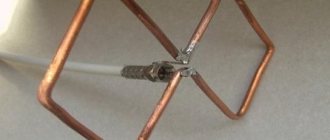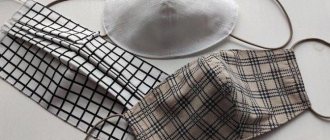A television antenna, which is made by yourself and is designed to receive a digital signal (DVB-T2), may not be inferior in quality to factory receiving devices. Depending on the task, terrain, operating conditions, a homemade antenna can be made in different ways. The design can be either very simple or performed after calculating a bunch of formulas. If you make accurate calculations, then you can successfully catch two multiplexes on your TV (each with 10 channels, a total of 20 channels will be received on TV).
Miniature set-top box with micro-USB OTG
If you are a radio amateur, then on the radio market you can purchase all the components for a homemade digital receiver. Such a homemade product may turn out to be several times cheaper than its certified counterpart. But you'll have to work on it.
Main components
In general, if everything is done correctly, the set-top box will work on mobile gadgets, TV and PC. As an example, you can assemble a DVB-T2 set-top box like a small stick. Main technical characteristics:
You can create an exact copy of the Geniatech PT360 whistle. The differences will only be visible on the body. Since the manufacturer will not be indicated there. This small gadget can work with a smartphone, tablet, Android TV-box, and even a Windows-based PC.
It is important to understand that soldering all elements of the console requires certain skills, knowledge and equipment. But you can do it easier and purchase a Chinese copy of the original DVB-T2 set-top box on the radio market or AliExpress, modify it to an adequate level and use it everywhere.
Reconfiguration
To create a copy of the Geniatech PT360 set-top box for digital television with your own hands, you need to open it in order to finalize it. It is recommended to modify the whistle if it gets very hot. Otherwise, you don’t have to go into its insides.
To open it, you need to carefully remove one half of the case. It should be taken into account that the body is fastened quite tightly.
Inside the case there is:
Datasheets indicate that the receiver supports terrestrial digital DVB-T/T2, cable digital DVB-C/C2 and analog. As for the heat sink, it is constructed as follows: “heat leaves the microcircuit through a through heat sink on the board (indicated by a red arrow) and along the copper substrate into the antenna braid.” In fact, the role of a radiator is played by a banal copper braid. With this approach, after a long period of operation, the heating reaches such a limit that you can simply burn your finger by touching the antenna output.
To prevent this baby from floating along with the microcircuit elements in a closed case in the summer, you can build a small radiator. Any 2.5 mm aluminum sheet is suitable for riveting it. For example, you can cut a primitive radiator from a profile. Then, using copper foil and hot glue, bring the foil layer out. In this way, heat is transferred to part of the board on the opposite side.
You can glue such a heatsink onto a memory chip using superglue and thermal paste:
Do everything as carefully as possible, since you only try once and it will be impossible to clean the glue that has been dropped in the wrong place.
For greater efficiency, glue the plate and copper foil together and bring it out.
Assembly and testing
After installing the homemade heat sink plate, close the housing cover and connect the antenna to the antenna input. You can also check operation with a whip antenna. And the experimental device will be a smartphone with OTG support and Android version no lower than 4.1. The same conditions apply to other gadgets.
Since the connected receiver will receive power from the device, the energy consumption will be equal to 1000 mAh battery for 3-4 hours of operation.
The gadget works with the PadTV HD application, but can also work with other programs for watching a television channel.
If the signal level is high-quality, then the found channel will remain in memory.
Using a microUSB - USB adapter, the TV tuner works perfectly under Windows. The OS can detect the drivers on its own.
Watch your favorite movies and TV series on any device thanks to More TV for only 299 rubles per month. Don't miss out on your 7 days FREE subscription!
Cat's house
Your cat is constantly sitting on the computer system unit, so give her the opportunity to finally win. Let the monitor become her comfortable home. This project gives you the opportunity to express yourself creatively. You can decorate the house with feathers or colored paper, glue wooden handles on the bottom and place the house at the desired height. A heating pad placed under the bed will make this place not just cozy, but also warm.
What is a TV tuner and its types
A TV tuner is a type of equipment that is used to work with a digital TV. It has advanced functionality that differs depending on the tuner model.
There are several types of TV tuners. Conventionally, they are divided into three categories:
Broadcasting involves decoding, which is carried out by a TV tuner. This is possible if one of the following standards is available:
The output can have several standards: built-in and external for PCs, as well as external for TV. The only difference between them is the port connection. The latest TV models, as a rule, have a standard USB connector, which replaces any port and does not require synchronization between the computer and television.
The operating system type is specified separately by the manufacturer. Each type corresponds to one of the computer programs: Windows, MacOS and others. Mobile operating systems, such as Android, are also found.
Which monitors can be converted
According to experts, to make a TV out of a monitor, liquid crystal monitors with a seventeen to twenty inch diagonal are suitable. The highest quality images can be obtained from products from the following manufacturers:
- "Sony".
- "Samsung".
- "LG".
It is necessary that the display has a wide viewing angle, otherwise it will be possible to watch TV shows only in one position: sitting directly in front of the display. Computer monitors do not always have a viewing angle of sufficient width, so it is necessary to give an objective assessment of this factor before remodeling.
Attention! For transformation, it is advisable to take even an old CRT monitor, with a seventeen to twenty inch diagonal. Rework is possible only in one case: if the screen image has not yet lost its brightness and clarity. It is wiser to simply throw away a monitor that has a cloudy picture.
How to make an SDR all-wave receiver and TV tuner in one bottle. My personal experience. I share with everyone.
It has been written and said many times, How to make an SDR all-wave receiver and TV tuner in one bottle? Yes, in fact, you don’t really need to do anything, with the exception of a civilian antenna on the roof for the required range and a foil cable (to eliminate losses and interference). I had a very simple task, to make an Internet connection link to the Internet (such as an echo signal repeater) without buying expensive equipment for radio communication, since there is a dedicated server and IP, and the Internet works on fiber optics. Why not do that!? I started looking for information on the Internet. Some fancy circuits or expensive equipment didn’t suit me at all. Soldering and etching boards takes a long time and is a hassle - RF connector on the cable, please. Looks like a USB flash drive. The antenna there is complete crap, but I use my J-antenna on the roof . I understood only one thing: the digital-analog receiver of the scanner should be based on a microcircuit from the well-known company Realtek RTL2832U / FC0013 and R820! Why is that? You ask. Because the Internet is full of all kinds of software specifically for it. Starting from TV receivers with a digital HD signal, to an SDR all-wave amateur receiver (for all frequencies). Frequency range from 25 to 1700 megahertz! Step 300 hertz. Not bad? Input - took a standard TV-female - easier to solder (adapter from PL-male, to TV-female - pitgale). Built-in MPEG, DUB/SUB, DVB-T decoders. Modulation? All types: AM, FM, CW, USB, LSB, NFM, SSTV, WFM, NMT, AMPS, DAMPS, GSM, and others. You can listen to amateur HF stations, here is an example, of pretty good quality . (Reception frequency 3666.6 kHz, LSB modulation). Not bad really. Listening to your neighbor's radiotelephone is no problem. It’s easy to listen to the ISS astronauts on 145800 mHz FM! Eavesdrop on: Cops, Ministry of Emergency Situations, ambulance, easily (but some have a specially encoded signal). Listening to bugs is easy and simple! And other uses for this toy! While it’s summer and not severe winter, what not to do and make 2 in 1: SDR all-wave receiver and TV tuner.
Bin
This project is worth noting for its sense of humor. After a little refurbishment, a broken old monitor turns into a trash can with a standard volume of 50 liters.
♥ BY TOPIC: The best thrillers: List of the best 35 films with descriptions, trailers and links.
How to choose the right tuner for digital TV
Watch your favorite movies and TV series on any device thanks to More TV for only 299 rubles per month. Don't miss out on your 7 days FREE subscription! Subscribe
A TV tuner for a TV must be selected based on several rules:
Useful: Which set-top box to buy for digital television
World Vision or BBK is considered one of the most reliable and at the same time budget brands. Manufacturers of these devices always focus on the latest digital TVs and multimedia updates. They take into account the wishes of customers, creating a better and more convenient device.
Recycling
The services of companies recycling monitors will cost much less than paying a fine.
In processing companies, the final cost is affected by:
- number of units written off;
- removal costs;
- attraction of special equipment;
- carrying out technical examination.
Parts divided by hazard class and component composition are sent for processing. Mercury waste is stored in an isolated room for no more than 24 hours and transported in sealed containers. Non-hazardous waste is transported in textile bags.
There are 8 factories in Russia that produce highly purified precious metals from computer equipment.
Old models
Bulky cathode ray tube monitors contain more hazardous compounds than modern ones. Analysis into constituent elements according to chemical composition is carried out automatically and partially manually. The sorted components are sent for recycling or disposal.
New models
Every year the share of plasma and LCD displays among electronic waste increases. For recyclable materials, dismantling is performed, in which the extracted elements are sorted according to their component composition.
In European countries and the United States, lead glass screens are suitable as raw materials for producing lead. In Russia there are no metallurgical melting furnaces for glass screens.
What is a built-in TV tuner?
After studying the characteristics of the equipment, the following question may arise: what is a built-in TV tuner for a TV. This is a TV tuner for a TV that is factory installed. This model has advantages, since during operation you will not need to connect the TV separately to the Internet. You can also avoid lengthy setup of functionality, which usually happens when using an external tuner. In addition, the built-in TV allows you to select broadcast standards.
Useful: Which TVs do not require a set-top box
Alternative programs and drivers
First you need to worry about replacing device drivers. To do this, use the Zadig program, which can be found either together with the downloaded software or on the website www.rtl-sdr.com/tag/zadig/. The above website shows installation instructions in pictures. On my own behalf, I’ll add that to search for a device called RTL2838UHIDIR, in the program settings it would be good to check the boxes next to “List all devices” and “Ignore Hubs or Composite Parents”.
What I liked the most was the SDRSHARP program. airspy.com/download/. I haven't looked into all of its settings, but overall it's quite functional. Changing the frequency is done by clicking on the upper or lower part of the digits of the displayed current frequency. The type of received signal is selected automatically, depending on the range. But almost everything can be selected manually. Using this program I was able to receive a signal in the range from 21 MHz...
... up to 940 MHz. The FM band even displayed RDS station information.
If you need to change the drivers to native ones from Realtek, then I found them here. Choose depending on the chipset. www.ukwtv.de/cms/downloads-aside/281-dab-player-von-andreas-gsinn.html RTL2838U + E4000
Turning a monitor into a TV: practical instructions
We provide detailed instructions on how to turn a second monitor you don’t need into a TV using a board. Remodeling stages:
- The first stage is to purchase all the necessary tools: a screwdriver with a soldering iron, a pre-purchased board, wires with solder:
- The second stage is to free the monitor from the “roof” by unscrewing the fasteners. They must be responsibly placed in some container to prevent loss before completion of assembly:
- The third stage is to find the expansion board and carefully disconnect it from the cable. If the cable is damaged, you will not be able to remake the monitor:
- The fourth stage is to check the markings of the screen matrix: using it you can easily find the necessary firmware for the device in order to select the proper voltage:
- The fifth stage is installing a new board. When carrying out the soldering process, it is necessary to observe the pinout of the display cable:
- The sixth stage - after attaching the Universal LCD Driver Board, you need to set the required voltage using a jumper (information about it should be found by reading the instructions accompanying the board). Usually twelve volts is enough.
The manufacturer equips such boards with IR radiation receivers. This makes it possible to control the TV using the remote control.
Attention! Before you begin assembling the monitor, you need to make sure that the sensor is turned on and find the location where exactly it is located. Often the infrared module is located on the outside of the case.
- The seventh stage (final) is the reassembly of the monitor, followed by turning it on.
Homemade antennas for DTV reception
On the territory of the Russian Federation, the implementation of the federal digital broadcasting program in 2022 was marked by the commissioning of two multiplexes with a completely free state package of 20 TV channels and 3 radio programs. The channels are not encrypted; they are transmitted in clear text in the UHF wavelength range. That is, for high-quality reception of digital public television, any antenna operating in the UHF range is suitable.
A little theory. The dimensions of the vibrators (the active elements of any antenna) must be equal to the full wavelength, half or a quarter of it. In the decimeter range, a radio wave has a length of less than one meter. This means that the dimensions of the elements must be consistent with this value.
The radio engineering literature describes many receiving designs for the UHF range. Most of them will perfectly receive modern digital television. The popular devices described below, which anyone can make with their own hands, have the following characteristics:
| Design option | Gain, dB | Reception range without amplification, km | Reception range with amplifier, km | Operating range, MHz |
| Cable loop | 0 – 3 | 15 | 15 | 440–800 |
| Antenna made from aluminum cans | 3 – 5 | 15 | 40 | 470 – 622 |
| "Butterfly" | 5 – 11 | 20 | 70 | from 300 MHz |
| "Triple square | 9 | 15 | 60 | 300 MHz and above |
| Antenna Kharchenko | 5 – 6 | 10 | 50 | from 300 MHz |
| Log-periodic antenna | 8 – 12 | 30 | 100 | more than 300 MHz |
Of course, these are not all designs of receiving antennas for digital television that can be made at home. There are a huge number of alternative options, but most of them have certain disadvantages:
A digital TV antenna recommended for DIY production must be effective, easy to replicate, and not contain expensive parts and materials. The designs discussed below fully comply with these parameters.
Note board
The main complaint about CRT monitors is their volume. But no one is stopping you from making the device compact with a small modification and giving it a new life. It can no longer become a flat monitor, but it can become a board for attaching notes, memos and papers. You just need to attach a cork board to the front of the monitor instead of glass. And wooden handles can be attached to the back for structural stability. In this way, you can also convert a flat screen monitor that has become unnecessary.











